|
Building the Tom Henry RS
Part
4: Suspension Mods, Tires, Wheels, Headers and other
Cool Stuff.
by Hib Halverson
At the end of Part
Three, we changed the valvetrain of the 3.8-liter V6 in
the Tom Henry RS. We installed new, Yella Terra
"Ultralite" 1.8:1, aluminum roller rocker arms, Katech
valve springs and Katech titanium retainers on our 3800
Series II V6.
Ultralites are nearly
25% lighter than the stock 1.6 rockers and 8% lighter
than the SLP aluminum rockers we took off. What's even
better about the new Yella Terra rockers is from where
in the rocker the weight was removed. It was mainly
taken from the valve end where mass reduction would have
more impact. The Katech springs (PN PSI-LS1511) have a
little more pressure than the Comp springs in the motor
previously and the Katech "ti" retainers (PN KAT-4678)
are a little lighter than the Comp retainers we took
off.
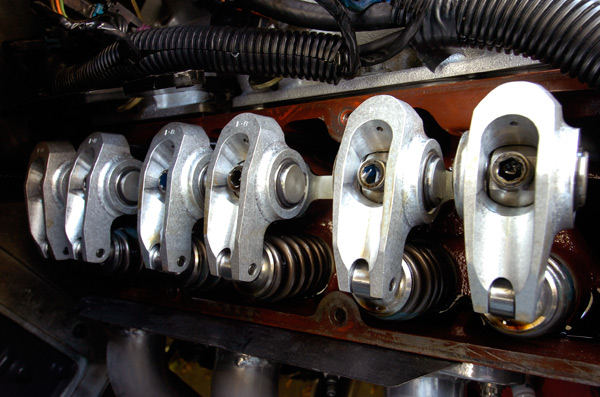 |
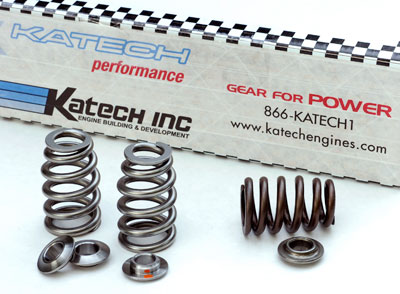 |
|
These parts saved us from
the valve float problems we experienced
during previous parts of this project.
At one time we were unable to get the
engine to run hard above 5700 rpm or so
because of that. A little less
valvetrain mass in the Yella Terra
Ultralite rockers and Katech titanium
retainers and a little more spring
pressure from Katech valve springs and
the valve float was eliminated. The
engine pulls safely to it's 6200 rpm rev
limiter. Image: CHpg Staff. |
Less valve train mass
and a little more spring pressure was the remedy for a
valve float problem we experienced when running the
engine over 5800 rpm. Before we went back to the dyno to
validate that theory, we wanted to get some drive time
on the new parts. We, also, wanted to have some headers
made for the car. Finally, we wanted to perform some
more suspension mods and add a few "safety" features.
|
A goal of this project was to have a 250-hp engine and
pass an exhaust emissions test–not just any old
"sniffer" test, either. It had to be the stringent
"Enhanced Smog Check" required in the State of
California's urban areas. Similar tests may be required
in a few other states. We took the Camaro to Quality
Auto Service in Pomona, California to see if the engine
would pass with the modifications to date. Owner, Mike
Garibay, is well-versed in emissions testing and service
work. His shop is one of our favorite general repair
facilities because of its good customer service.
The Enhanced test combines inspection of
emissions parts with an exhaust gas test taken
while the car runs on a moderately-loaded
chassis dyno at both 15 and 25 mph. We easily
passed the test. In fact, Garibay commented that
he didn't see very many mod'ed cars that ran so
clean. |
|
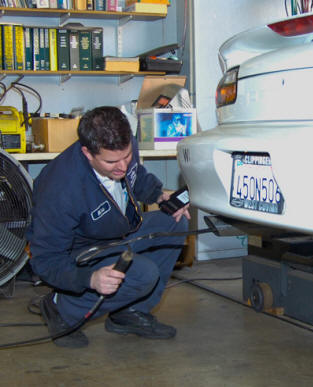 |
|
Mike Garibay readies our
car for Smog Checking by inserting the
"sniffer" in our Flowmaster exhaust.
Image: CHpg Staff. |
|
Suspension, Wheels,
Tires
The Tom Henry RS's rear
suspension felt, well... "sloppy" is the best way we can
describe it, in accel/decel transitions, during quick
shifts at wide-open-throttle or on roads were slab
joints or tar strips get the suspension hopping. This is
caused by the soft rubber mount GM stuck on the end of
the rear axle torque beam along with the weak-suck,
stamped-steel beam flexing under load. Another problem?
During hard acceleration, drive torque acts on the
beam's length to decrease rear tire loading. This
reduces traction, both in a straight line and
accelerating out of corners. Lastly, when you lower a
3rd or 4th Gen Camaro, traction degrades even more due
to decreased anti-squat caused by the change in rear
suspension geometry.
Popular with
autocrossers, road racers and drag racers is Global West
Suspension's "TracLink" assembly (PN TSC-23). It alters
rear geometry such that its leverage point moves to a
more optimum location.
Drive-torque-induced tire loading changes from negative
to positive improving traction
during acceleration, both straight line and out of
turns. What's more, TracLink eliminates wheel hop and
has a pinion angle adjustment. Finally, of interest to
drag racers required to add a driveshaft loop, the
mounting points for that are built into the TracLink.
|
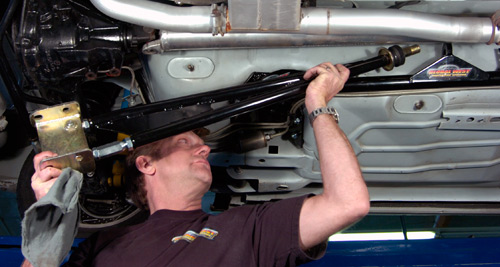 |
|
Global West's owner, Doug Norrdin, and
an assistant, installed the TracLink (PN TSC-23) in a
few hours using a drill and common hand tools. For the
complete photo sequence showing how to install a
TracLink,
click here.
Image: CHpg Staff.
|
Global West markets
this product mainly for V8 cars, but the kit for a 3rd
Gen V8/automatic Camaro, also, fits a 4th Gen V6. The
installation requires removal of the left rear seat
cushion, drilling some holes in the left rear seat well
and one hole in the transmission mount crossmember.
Other than that, TracLink is a bolt-on for all 4th Gens.
|
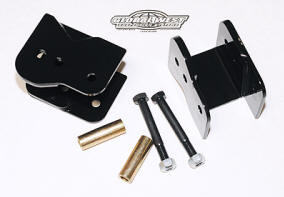 |
|
The Global West
Anti-Squat Bracket kit for 82-02
Camaros. Image: CHpg Staff. |
|
Like some racing-derived performance enhancements,
this one has compromises for road cars. When it comes to
noise, TracLink is not for
the faint-hearted because, since it
dispenses with the large rubber isolator at the front
end of the torque beam, powertrain noise
and
vibration in the interior increases. We totally want the
Global West TracLink's positive affect on acceleration
and handing, so we'll take the noise, however, those
expecting Camaros with modified suspensions to have
interior noise-and-vibes levels the same as or close to
stock should carefully consider this product. |
|
The TracLink installation was done by Global West's
technicians at its factory in San Bernardino, California
and included the addition of "Rear Anti-Squat Brackets"
(PN VTC-27). These brackets must be welded to the rear
axle housing. Once in place, they compliment the
TracLink by further improving traction exiting turns.
Additionally, they are ideal for a lowered car because
they further alter rear suspension geometry such that
its instantaneous center moves to a point more
appropriate when ride height is reduced. That
change increases the rear suspension's percentage of
anti-squat such that that car tends to hook better
during hard acceleration.
Lastly, these brackets have two positions for
the rear control arm pivots allowing drag racers
to adjust the car's bite for track conditions or
changes in ride height. With the TracLink and
Anti-Squat Bracket installations complete, we
bid all the good people at Global West farewell
and headed back to our shop. |
|
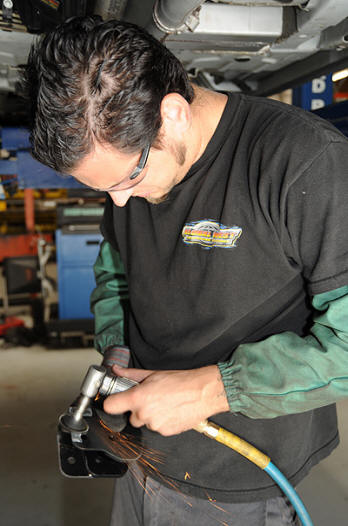 |
|
Like most of Global's
suspension parts, the Anti-Squat
Brackets are black powder coated.
Because the brackets must be welded in
place, the coating must be removed in
the places where welding will take
place. Here, Global's Eric Norrdin uses
an abrasive disc to do that. For a photo
sequence showing how to install these
brackets,
click here.
Image: CHpg Staff |
|
We wanted more
radical tires and wheels, so we swapped the 245/50ZR16
Goodyear Eagle F1 GS-D3s on stock, 8" wheels we'd been
using up to now for a set of 265/40ZR17 Eagle F1
Supercars on 9.5" Fikse Profil 5Ses. We should add that
the F1 GS-D3s were on the car for several years
providing good dry and wet traction and outstanding
tread life on a car that gets driven pretty hard.
|
 |
|
The Fikse Profil 5S is a
forged-aluminum masterpiece. Each is
assembled with aerospace fasteners and
is serialized to facilitate quality
control and help verify ownership
of–heaven forbid–a stolen wheel. Image:
Paul Conrath/Fikse USA. |
|
The Fikse (it's "fick-sea" not "fis-ski", by the way)
Profils are awesome-looking wheels. Because Fikses are
so light for a street wheel, we could go from a 16x8 to
a 17x9.5 yet not increase unsprung weight, but we
expected this, considering their racing pedigree–cars on
Fikses have won both the World's preeminent endurance
races, the 24 Hours of Daytona (4 times!) and the 24
Hours of LeMans.
The Fikse Profil 5S is a modular design with a
rotary-forged, CNC-machined, clear powder-coated,
aluminum center. The rims are forged, heat-treated
aluminum. "TechniPolish" is Fikse‘s standard finish and
features a robust, liquid-cured clearcoat on the
diamond-turned center section. The mirror-polished rims
are left polished and uncoated to allow for touch-ups as
needed in case of minor scrapes.
|
|
While brothers Matt and
Jim Fikse (yep, it's a family operation with their name
on the building) couldn't share specific manufacturing
secrets with us, they did reveal that, unlike most wheel
companies, Fikse USA manufactures its own centers and
rim halves. Having done that since 1992, makes Fikse one
of the few companies in the U.S. that controls the
wheel-making process from start to finish. Doing that
enables it to maintain a high level of quality few
manufacturers can equal and none exceed. Fikse builds
4th Gen. Camaro wheels in two offsets, 38mm and 51mm. We
chose the 38s because they slightly widen the car's
track for a better look.
Needless to say, Fikses
are not cheap, so wheel locks are manditory to deter
theft. Initially, we reused the stock Camaro wheel locks
but they didn't look very good. The Profils come with
high-quality, McGard wheel nuts so we went looking for a
set of McGard's locks, figuring they'd better match the
nuts' appearance.
|
|
 |
|
Each of these wheels
weighs about as much as the stock 16x8s
they're replacing, in-spite of being
larger in diameter and wider. Image:
CHpg Staff. |
|
|
 |
|
To protect high-end
wheels, you want experienced tire
specialists, like Tucker Tire's Bernie
Berthet, mounting your tires. Fikses
require specialized mounting procedures
and Tucker provided that service. Image:
CHpg Staff. |
|
McGard makes perhaps
the best wheel lock in the industry. They're made of
hardened steel...not just "case-hardened," but
hardened throughout and tempered. Like most locks,
they require a special "key tool" and the design of the
key and the pattern in the lock allow a virtually
unlimited number of computer-generated combinations.
To install or remove
the lock, the key's collar, aligns the key to the lock.
All you need to is gently push the key over the lock
then turn the key until the patterns engage. McGard
locks are nickel-chrome plated. Basically, these locks
will probably outlast the car. The simple function,
outstanding security and excellent durability of the
McGard design might be why they're OE on some 30 car
lines, worldwide.
|
|
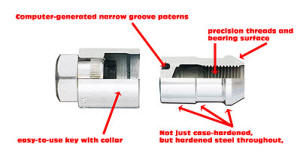 |
|
Image: McGard, LLC. |
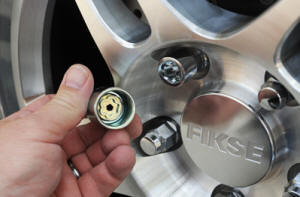 |
|
What makes the McGard
locks easy to use is the key's locating
collar. You just gently push it on the
lock and turn until it engages. The
locks, themselves, look much better on
our Fikses than did the OE GM locks.
|
|
Jumping from the F1
GS-D3 to Goodyear's ultimate, dry traction tire, the
wider, more grippy, F1 Supercar; improved straight line
bite, cornering power and steering response. The
Supercar, in 265/40ZR17, was originally developed for
the C5 Corvette Z06 and is one of only a few tires which
bridges the gap between all-round, ultraperformance
tires, such as the "D3", and DOT-approved, radial road
race tires which are not acceptable for general street
use because of short tread life and almost nonexistent,
wet traction. While the F1 Supercar is more sticky than
what we took off, admittedly it's not the drag race tire
that a "drag radial" from Goodrich, Nitto or Goodyear
might be. Perhaps we'll try one of them in the future.
The main advantages to
the Tom Henry RS with the F1 Supercars are improved
at-limit handling due to more traction coming from a
wider tread, more aggressive rubber compound and a tread
block design skewed towards handling. Additionally, the
F1 Supercar casing is designed to improve steering feel
and response. |
|
Where the Supercar
gives-up a little to the F1 GS-D3 is in 1) wet
traction--the D3's tread design is superior when it comes
to channeling water away from the contact patch 2) tread
life--because the Supercar has softer rubber and more
shallow grooves--and 3) noise and harshness.
We hauled the Fikses
and Goodyears over to Covina, California's Tucker Tire
Service Co, where they were mounted and balanced. On
return to our shop, we stuck the THRS up on jacks and
swapped the tires and wheels then torqued the McGard
nuts and locks. Man...those Fikses and F1 Supercars are
just so damn pretty!
|
|
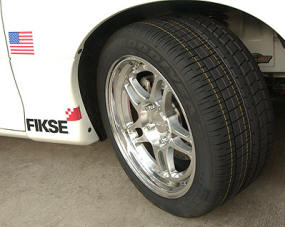 |
|
The Tom Henry RS on Fikses and F1
Supercars. The Goodyears really grip by virtue of very
rigid blocks on the outside of the tread and shallow
tread depth. Image: CHpg Staff.
|
|
Rollback Blues
After a month or so
running the new valvetrain pieces, we decided to check
how modifications to date affected the car's 1/4-mile
performance. We often acquire acceleration data using a
Vericom Performance Computer, a benchmark for
medium-priced, self-contained, vehicle dynamics testers.
These units are used by government agencies, vehicle
manufacturers, tire companies, independent testing
facilities and discriminating car enthusiasts needing
accurate vehicle dynamics data from an on-board device.
The Vericom VC3000 has a two-axis accelerometer core,
400Hz sampling rate, and ability to upload data to a PC
via a USB port. It displays data on a 128x64 LCD screen,
can recall up to 256 tests from memory and–we saved the
best for last–with the DAQ model, ability to record
engine controls data via the car's diagnostic link
connector (DLC) as well as from up to six optional
sensors.
We installed the
VC3000DAQ, then headed for our back-road testing venue,
but in a "reality bites" moment, part-way there; the car
quit. We came back to the shop riding in a
Freightliner rollback with our wallet 120 bucks lighter.
|
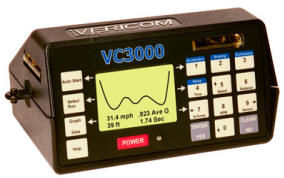 |
|
The Vericom VC3000's
large display and improved keyboard make
it nicer to use. The built-in bubble
levels make mounting and leveling the
Vericom before use quite easy. Image:
Vericom Computers. |
|
Some failure caused by
our mods? Hardly!
After doing the "cranks
but won't run" diagnosis in the Camaro Service Manual,
we figured the fuel pump was bad. We pulled the
exhaust–potentially a nightmare job made easier with
Eastwood's "EZ-Pull" exhaust joint separating tool (PN
43583)–drained the fuel, got the gas tank out, pulled
the pump "bucket" and bench-tested it.
|
The pump was stock,
went 58,087 miles and...was deader than a freakin' door
nail. Sheesh! So much for GM fuel pump durability. We
emailed Racetronix and ordered its High Performance Fuel
Pump System (PN F99-FPKG-2).
We had to make use of
the downtime while we waited for the Racetronix parts to
arrive, so we worked on changes to the car which would
improve safety when driving at higher speeds in wet
weather or at night.
Believe it or not, it
does rain in Southern California and a few storms late
last winter had us trying Super Silicone wiper blades
(PN 93060) from WeatherTech Auto Accessories. Made for
WeatherTech by PIAA from "activated" silicone rubber, as
the blade wipes; it leaves a slight residue which builds
over time, causing water to bead making the wiper's job
easier. Silicone WeatherTechs are more durable than
typical rubber units, too, so they hold a sharp edge
longer.
|
The THRS needed better headlights–not cute, blue bulbs,
either. We wanted lighting which works, so we installed
Harrison-Toshiba, Halogen Infrared Reflective (HIR)
bulbs (PNs 9011, 9012) from Daniel Stern Lighting, a
performance lighting components distributor. Not
"over-wattage", blue-tinted stockers, Harrison-Toshiba
bulbs' critical dimensions are the same as O.E., so they
fit right into the stock Camaro light assemblies. They
use HIR technology which eliminates the short life,
greater heat production and higher current draw of
over-wattage bulbs. Their power consumption is the same
as stock, yet the low beam produces 87% more light and
the high-beam, 50% more light. Stern's HIRs enhanced our
nighttime driving safety. |
|
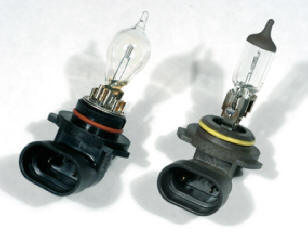 |
|
A Harrison-Toshiba
Halogen Infrared Reflective (HIR) bulb
(left), is reminiscent of an
old-fashioned light "globe," but that's
where similarity ends. An
optically-transparent coating on the
inside of that spherical section
reflects infrared radiation back at the
filament, making it hotter so it
produces more light than it can by
current flow, alone. Image: CHpg Staff |
|
 |
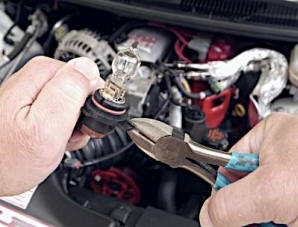 |
|
An HIR bulb (right) must
be modified by trimming the tab in the
areas shown inside the arrows. The
resulting tab is shorter and more
narrow. Trimming is easy with a pair of
wire cutters. Image: CHpg Staff |
The Tool Man Cometh
|
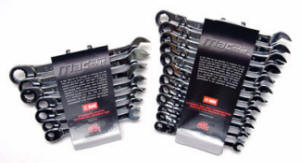 |
|
Buying the Mac Edge
ratcheting wrenches was sort of a
"well...duh" moment for us. Once we
started using them, we couldn't
understand how we lived without them.
Image: CHpg Staff. |
|
About the time we
finished the headlight bulb installation, our Mac Tools
truck stopped out in front–perfect on a day which was
slow out in the shop and the day after pay day. We spent
some more money with the Mac man and acquired additional
tools to make our project less tedious. Ratcheting
combination wrenches are the rage these days and we'd
been slow to get hip to that sitch, but not any longer.
From Mac Tools, we picked up two sets of them for SAE
(PN SRW27K) and metric (PN SRWM212K) fasteners.
These wrenches are in the "Mac Edge" line, all of which
use some unique "socket" technology which makes using a
combination wrench use easier. |
We
bought Mac Tool's "Zero" ratchets in 3/8-drive (PN
XR8PAZ) and 1/4-drive Flex Head (PN MR7PAZF). Several
tool makers have ratchets with as little as 5° lash,
however, the lower lash mechanism makes a weaker tool.
The Zero uses a cam and roller-bearing assembly–like a
sprag in an automatic trans–so it has no lash. This
makes for easier use in tight spots, but also, a strong,
durable tool.
|
 |
|
After using these Mac
Tools "Zero" ratchets for a while we
like the soft rubber handles more than
the zero-lash feature. Image: CHpg
Staff. |
|
|
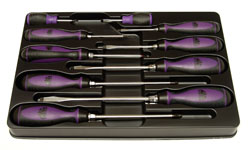 |
|
Since some of the screw
drivers in the shop are kinda ratty and
others have "disappeared," a new set was
in order. We appreciate Mac's
comfortable handles and, well...we have
a thing for purple. Image: CHpg Staff. |
|
|
The original thermal insulation on the engine's
fuel hoses needed replacement and we wanted to
insulate other fuel system parts near the
engine, too. We cut the tattered O.E. stuff away
and replaced it with Design Engineering's Heat
Sheath (PN 010419), using longer lengths to
insulate more of the hoses. We used DEI Cool
Tape (PN 010413) to bond the Sheaths to the
hoses. We cut a 7x10" square of DEI Floor and
Tunnel Shield (PN 050503) to cover the ends of
the hard fuel lines adjacent to the left exhaust
manifold. All this was to keep the fuel cooler.
More Cool Tape repaired insulation on crankshaft
and camshaft position sensor wiring where it
passes through a very hot area adjacent to the
EGR valve. Lastly, in preparation for our header
installation, we added DEI Protect-a-Boots to
our MSD plug wires.
|
|
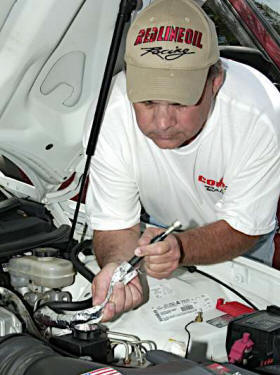 |
|
The stock fuel lines are
wrapped in insulating sheath over a
length of them routed above the left
exhaust manifold. The original sheath
was pretty ratty so we replaced it.
Image: CHpg Staff. |
|
|
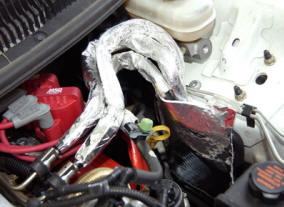 |
|
Design Engineering's
Heat Sheath is generally the same as
what GM wrapped on fuel hoses at the
factory. We added additional heat
reflective material to shield the fuel
lines which run along the left subframe
rail adjacent to the left exhaust
manifold. Image: CHpg Staff |
|
To date, since the THRS is also a daily driver,
we racked-up a lot of miles doing this project,
so it was time for an oil change. We drained the
oil, changed filters–we use the LT1 V8's larger,
PF52–then poured-in five quarts of Red Line
10W30 synthetic engine oil. Since our V6 has no
oil cooler, we're running it to higher rpm and
we're making more power, 225° F oil temperature
is not unusual and we see 250° on hot days at
high speed. Red Line gives us a needed
durability enhancement at those high temperature
levels. |
|
On our final day of waiting for the fuel pump,
we installed what we feel is the best shift
light for pod installations: Auto Meter's
Digital Pro Shift System (PN 3389). The "DPSS"
has a shift light, in seven colors which can be
selected by the user; five programmable shift
points and a digital RPM display. All the
programming is done by pushing the three, small
buttons on the gage's face. Simple programming
instructions are in the DPSS's manual. We put
the DPSS and a Sport-Comp II electric oil
temperature gauge (PN 3656), into an Auto Meter
pod (PN 10210) mounted on the THRS's left
A-pillar.
RPM data for the DPSS
came from the ignition module's low-resolution, engine
speed output, circuit #430, a purple/white wire going to
pin #8 of the ECM's blue connector. This is a critical
circuit. If there's a problem with it; the engine will
not run, so the splice needs to be soldered and properly
sealed.
|
|
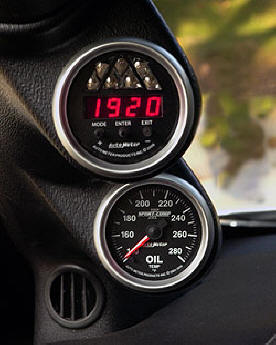 |
|
The Auto Meter DPSS's
tach display is easy to read. Its LED
shift light is visible in bright
daylight and brilliantly intense at
night. In fact, after dark, most people
will use the DPSS's dimming feature. A
full-sweep, electric oil temperature
gauge and one of Auto Meter's
gauge pods for 4 Gen Camaro A-pillars
rounded-out our aftermarket
instrumentation. Image: CHpg Staff. |
|
|
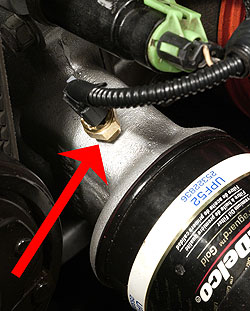 |
|
We removed the oil filter
adapter, chucked it in a drill press,
drilled and tapped a hole for 1/8th-pipe
thread and installed the oil temperature
sender. Afterwards, thorough cleaning is
required. We installed the adapter with
a new oil filter adapter gasket and an
ACDelco PF-52 filter both from our Chevy
parts source, Tom Henry Racing. Image:
CHpg Staff. |
|
We passed on oil pan mounting for the oil
temperature sensor because it required pan
removal and welding. It was easier to remove the
oil filter mount, drill into its output side and
install the sensor there. Plus, that gave us a
chance to use a Standard Abrasives Porting Kit (PN
260001) to deburr and polish inside of the passage which
runs from the filter to the block's main oil
feed. |
We're Pumped
|
Our next THRS work session occurred right after
FeEx Ground kicked our
Racetronix shipment off the back of
their truck. Since we're eventually going to add
nitrous to the Tom Henry RS, we needed a pump
upgrade, anyway. The Racetronix High-Performance
Fuel System (PN W1-FPK-2) for '99-up V6 Camaros
fits the bill. It consists of a high-volume pump
assembly, the core of which is a Walbro 255
gerotor pump, and an auxiliary wiring harness.
The Racetronix's up-to-67 gal/hr. flow meets a
nitrous-injected engine's greater fuel
requirement with ease. |
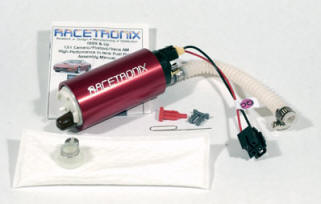 |
|
The pump part of the
Racetronix High-Performance Fuel System.
For a sequence of photos illustrating
how to replace the stock fuel pump with
the Racetronix,
click
here. CHpg
Staff. |
|
The Racetronix supports
GM's "venturi feed" (prevents starvation at low fuel
levels), uses the production, plastic fuel feed tube
rather than a less-durable rubber replacement and stock
electrical connectors.
These pumps cause
voltage drop and increased heat in stock wiring due to
higher current draw. The solution is Racetronix's wiring
harness which includes 10-ga. wire, a relay and
stock-type connectors. It brings power directly from the
car's alternator back to the fuel pump and uses the
existing fuel pump power supply to run the relay. The
harness is assembled with soldered connections, is
inside O.E. split-loom and is accompanied by excellent
instructions. We wish all products like this were as
well-executed as the Racetronix Fuel System.
During the installation
of the Racetronix hardware, we disconnected the battery
and while we were there, decided to test it with our
shop's Auto Meter BT350 Battery and Electrical System
Tester. It's a computerized, hand-held, diagnostic
device which performs battery voltage and load, starter
draw, automated voltage drop and alternator tests. This
is a professional-grade device which test batteries with
CCA ratings of from 200-1600. It has digital display and
a memory which records the most recent 50 tests.
|
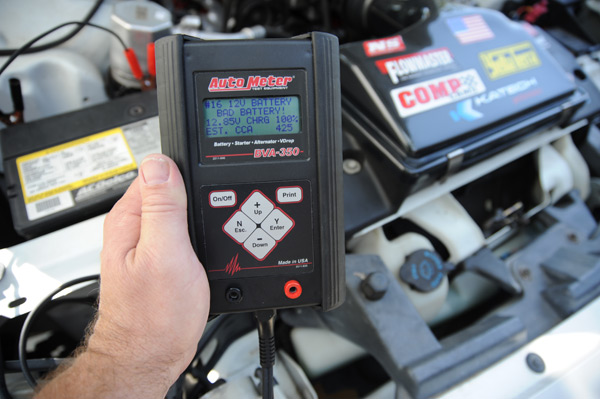 |
|
The Auto Meter battery
tester tells all. It determined that
what was originally a 690 CCA battery
now capable of only 400 CCA. Time for a
new battery. Image: CHpg Staff. |
|
Admittedly, the Auto
Meter is sort of expensive, but if you have a
fleet of cars like we do here at the Camaro Homepage,
being able to accurately test batteries and charging
systems avoids unnecessary purchases of batteries,
alternators or other charging system parts. According to
the BVA-350's display–just our luck–the project car's
original Delco battery tested as "weak". We yanked out
that old battery and dropped it off at Kragen Auto Parts
for recycling.
The best choice in
batteries for a performance car is the Odyssey, made by
EnerSys Energy Products in Missouri. Popular among
racers with high compression engines, car audio
enthusiasts, diesel pick-up owners, off-roaders whose
trucks have winches and those who will pay extra for a
battery with long service life, the Odyssey has earned a
solid reputation in the niche market that is premium car
batteries. Admittedly, an Odyssey battery is not cheap,
but they are a high-value product because of their
durability has them capable of outlasting just about
everything else on the market of comparable size and
cold cranking amp (CCA) rating.
|
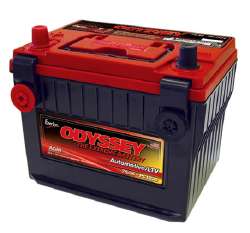 |
|
An EnerSys Odyssey 75/86 battery. It
accepts either side or top connections. Image: EnerSys
Energy Products, Inc.
|
|
Some batteries provide
enormous cranking power–others, deep cycle reserve
power. EnerSys designs its products to do both. How so?
One reason are flat plates made of pure lead rather than
lead alloy. Pure lead plates can be made thinner, so
more of them fit into the battery. Lots of plates mean
more surface area and that means more power, up to two
times that of some conventional batteries.
Odysseys are capable of
providing five-second cranking pulses far in excess of
their CCA ratings and that's often, two-to-three times
the pulse rating of equally-sized conventional
batteries, even at low temperatures. Odyssey's can
handle deep cycles, too--as many as 400 charge-discharge
cycles to 80% discharge.
|
|
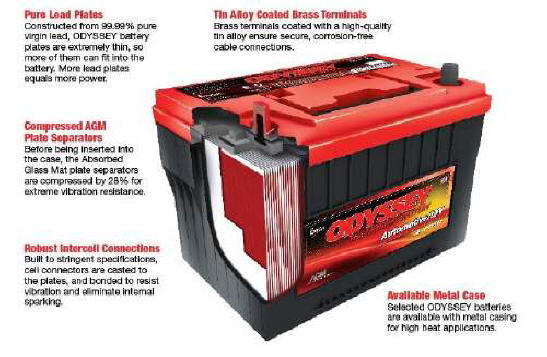 |
|
The 75/86 has a CCA
rating of 730-amp, a 5-sec. pulse hot
cranking amp rating of 1230 and a hot
cranking amp rating of 815. It's reserve
capacity is 100 minutes. Image: Image:
EnerSys Energy Products, Inc
|
|
Rugged construction,
Absorbed Glass Mat (AGM) design, vibration-resistant
welded, intercell connections and tough,
corrosion-resistant, tin-plated brass terminals combine
to give the Odyssey Battery reliability and durability
such that they have a 3-10 year service life. Further,
the AGM design prevents spills, even when installed on
its side. Unlike conventional batteries, Odysseys can be
stored for up to two years and still be returned to full
power.
|
The particular Odyssey
(PN PC1230DT) we put in the Tom Henry RS is a dual
terminal unit which EnerSys calls a "Group 75/86
battery". It has top terminals (typical of a 75) and the
side terminals (typical of an 86) used in GM cars from
the late-'60s to the mid-'00s. It's rated at 730 cold
(30-sec. at 0°F) cranking amps and 1230 "starting pulse"
amps (5-sec. at 68°F). This unit weighs 45.5 lbs, 10.2
lbs more than the O.E. Delco we took out. There are no
free lunches. The Odyssey's extra plates cost some mass,
but...we'll "loose it back" when we exchange the car's
stock, cast iron manifolds for headers.
|
|
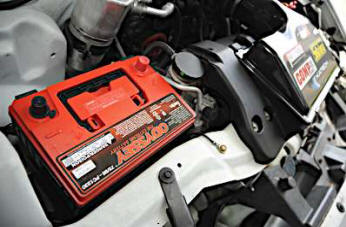 |
|
The Odyssey quickly
installs in a Camaro. The integral
handle makes getting it in and out a
snap. Image: CHpg Staff. |
|
|
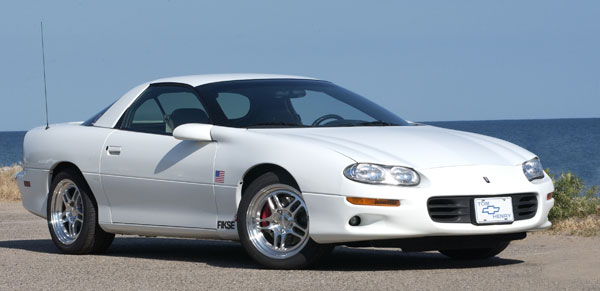 |
|
With a new fuel pump and a new battery,
it was time to take a break and drive to Goleta, a
seaside town in central California for a weekend away
from working cars. The THRS looks pretty snazzy with its
Fikse wheels. CHpg Staff.
|
|
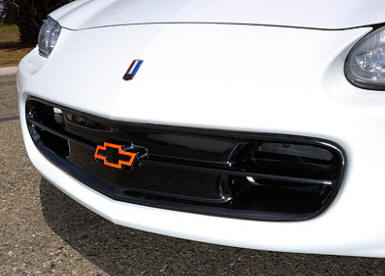 |
|
The SLP grille looks much
better than the stocker, weighs about
the same and is a bolt-on. Image: CHpg
Staff. |
|
Looking at our Fikse Profil 5S wheels, we
decided the car's front view needed more visual
accent, so we ordered SLP Performance Part's
Replacement Grille (PN 50388). It's
injection-molded, has a gloss black finish and
carries a red Chevy Bowtie. It looks a heck of a
lot better than the stock piece. |
Next, we looked for
some twisties for action photos and to try out our new
wheels and tires. Compared to the 245/50ZR16s they
replaced, our 265/40ZR17 F1 Supercars put more rubber on
the road and have slightly less tread depth, so we
quickly confirmed an improvement in lateral grip and
steering response. In addition, the 17x9.5" Fikse
Profils were conspicuous in what they didn't do: degrade
handing with additional unsprung weight, in spite being
1.5" wider and an inch bigger in diameter.
|
 |
|
Finally–a chance to run
The Tom Henry RS hard on some curvy
roads. Clearly, our numerous handling
enhancements made a significant
improvement. Image: Gary Peterson. |
With brake dust on the
wheels and dead bugs on the nose, the Tom Henry RS
needed washing. Fikse USA says to wash their wheels with
1:1, Simple Green and water. Then, we did the whole car
with another Simple Green product, "Car Wash". To keep
the Fikse's TechniPolished aluminum rims gleaming, we
treated them with Adam's Metal Polish #1 and #2.
The Heads-Up on Headers
While the Extrude Honed, stock exhaust manifolds
installed in Part Three improved flow on a per-manifold
basis, even after we had Extrude Hone AFM process them,
they had flow differences between each primary pipe. In
addition, the right manifold's #1 and #3 primaries
intersect at 90°. At minimum that would cause
turbulence at the junctions and turbulence causes
restriction. While Extrude Honed stock manifolds are
good if you're on a tight budget, because we wanted to
get the exhaust flow more consistent on a
cylinder-to-cylinder basis and nitrous oxide injection
increases exhaust flow; it was time to put headers on
because of their overall reduction in restriction and
more consistent cylinder-to-cylinder flow numbers.
|
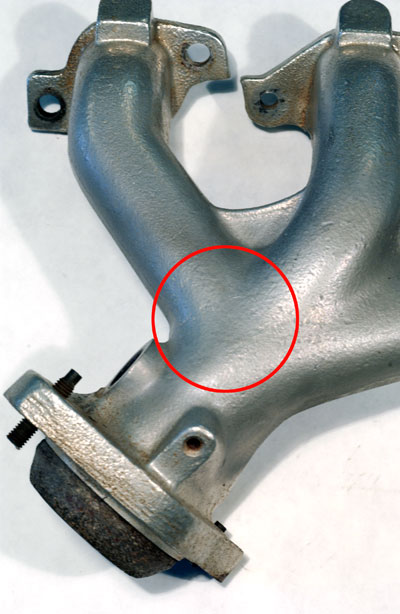 |
|
Inside the right exhaust manifold in the
area circled is where we believe there is exhaust flow
turbulence and restriction. Image: CHpg Staff.
|
|
First, we researched off-shelf headers for the
V6 4th Gen F-car. RK Sport lists a header for
the 3800 but at the time we were preparing this
story, RK Sport told us that sales of that part
had not been real good and that once stock ran
out, it probably discontinue the product. Faced
with testing and covering a product which, going
forward, might not be available to readers; we
moved on. Pacesetter also markets a shorty
header for 3800s in Camaros, however, one part
number covers all '95s to '02s and we read
enough anecdotal accounts on the Internet of
98-02 V6 owners having difficulty with the EGR
connection on the left header that we decided
that product wasn't for us, either.
Clear Image Automotive makes a shorty header for
F-car 3800s that comes highly-recommended by
anecdotal accounts on the Internet, however, in
the pictures we saw on its web site, the left
header has the same problem as do the
Pacesetters–they won't bolt up to the 98-02 EGR.
An email inquiry to Clear Image for more
information went unanswered. |
There are some other
choices out there, such as the equal-length, 3-into-1
race headers from Force Fed Fabrications, however, they
require user fabrication of the connection to the rest
of the exhaust and, since this was not an all-out race
car and we needed a stock cat converter, Force Feds, as
good as they are, wouldn't work.
|
Confronted with one
header which will be discontinued and three others which
would require us to supply some level of fabrication
and/or modification to get them to fit the car, we
decided to accept an offer from Dawson Racing Headers to
prototype a set of bolt-on, shorty headers for 3800
Series IIs in '98-'02 Camaros using our project car.
|
|
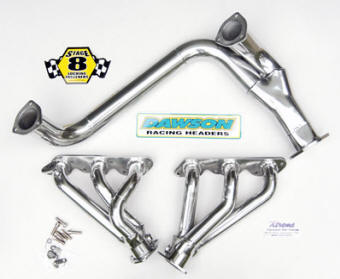 |
|
Next to go on
the Tom Henry RS was a set of
custom-built exhaust headers from Dawson
Racing Headers. Image: CHpg Staff. For a
photo story about how headers are made,
Click Here
|
|
Dawson
Headers, in Nuevo, California, was owned by former
Hooker Headers engineer, Tom Dawson. The company had 20
years of experience and did premium headers for
everything from Top Fuel cars to tractor-pullers,
including Camaros–all of 'em, from '67 to '02 and
'10-up, street or race, and with just about any engine.
|
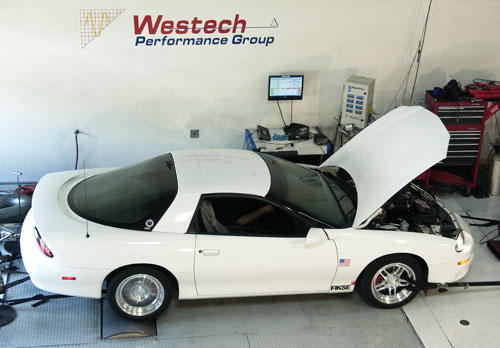 |
|
With Dawson Headers and
1.8 rockers installed, it was once
again, onto the Superflow chassis dyno
at Westech Performance Group to validate
the work done to date. |
|
Our Dawsons
are a shorty design. Their oxygen sensor bungs are in
stock locations. The headers are designed with easy
access to header bolts and the Denso IT-20 spark plugs
we like to use. The connection on the left header's #1
primary pipe is configured to bolt-up to the '98'-02 EGR
plumbing.
The mounting
flanges are 3/8-inch, laser-cut, mild steel. The primary
pipes 1 5/8-in. diameter, 16-ga. (.065" wall), 1010 mild
steel tube stock. All curved sections are are mandrel
bent. Most joints are tungsten inert gas (TIG) welded,
however, typical of high-end race headers, the outside
of each pipe-to-flange joint is TIG, silicon-bronze
brazed. The collectors are 2.5-in diameter 16-ga. mild
steel. The Dawson Racing Headers' system for a 3800
Camaro includes a 2.5"-into-3" y-pipe with a bolt-up
connection which must be welded on the stock catalytic
converter.
Sadly, on
Jan. 24, 2009, a couple of years after he did the
headers on the Tom Henry RS, Tom Dawson died of
complications due to diabetes and kidney problems. Tom
was astonishingly good when it came to designing and
building headers. He could look at an engine, take a
piece of tubing cut and bend it and it would fit
perfectly. Tom will be missed. He was a big guy with a
big heart and one hell of an artist with a tubing bender
and a welder.
Once the
headers were complete, we sent them to Extreme
Performance Coatings to be treated with the company's
ceramic-chrome exterior coating and its "MCS" interior
insulating coating. Extreme Performance uses coating
materials from one most innovative and well-established
suppliers in the industry, Techline Coatings.
First, the
headers are aluminum-oxide grit-blasted then washed. The
outside treatment is fairly basic: a ceramic-metallic
coating is applied with conventional equipment. What's
unique is the proprietary process Extreme uses to coat
the interior of a set of headers with a thermal
insulating compound. After the outside and the inside
are done, the parts are baked to cure the coatings.
The idea
behind the coating is to keep the exhaust heat in the
headers such that cat light-off doesn't become a problem
and the amount of heat radiated to the vehicle interior
decreases. Extreme's MCS inside pipe insulating coating
is the first barrier and the ceramic-chrome exterior
coating is the second.
We installed
the Extreme-coated, Dawson Headers using Fel-Pro
gaskets, new Denso oxygen sensors (PN 234-4018) and
Stage 8 Locking Fasteners.
Finally, the
THRS Team met at Westech Performance Group for another
chassis dyno session. First, Z-Industries,' Drew Zimmer,
updated our computer programming, then we tested the
Whisper Motorsports air box lid we installed in Part 3,
using a stock air box fitted with a Green Filter as a
baseline. Then, we switched to the Whisper Motorsports
carbon fiber air box lid with the Green Filter and
gained an additional 2-hp at peak power and 5-lb/ft at
peak torque.
|
With the
Whisper Lid in place, at the rear wheels, the Tom Henry
RS peaked at 219.1 SAE horsepower at 5700 rpm and 214.0
pound/feet torque at 4600 rpm. Figuring 18% driveline
loss that's 267-hp SAE at the flywheel, 17-hp more than
our original goal of 250 and 70-hp more than stock. Not
only is that an improvement–13-hp–over the last test in
Pt. 3 (to see that data, click here), but that peak
moved higher and the power curve extended to about
200-hp@6100 rpm whereas before, it dropped-off past
5500. From a drivability standpoint, for a V6, the Tom
Henry RS is a stump puller on the street with a fat
torque curve which is above 190 lbs/ft from 1900-6200
rpm. No doubt–Dawson Racing Headers along with all our
other mods work very well! |
|
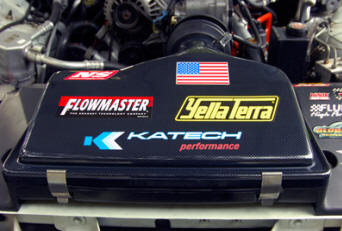 |
|
This is the Whisper Lid as installed on
the THRS. This replaced an SLP lid designed for a V8
which leaked around the filter and required some complex
ducting to the engine. Image: CHpg Staff.
|
|
While the
car did make almost 220-hp, we noticed a little dip in
the numbers right before peak power. We were running the
car on pump gas and attributed the dip to some
detonation and ensuing knock retard. In the last part of
the series we had trouble with KR but this time, it was
coming at a different point in the power curve. We added
three gallons of Rockett Brand 100 octane Racing
Gasoline, then ran again, and the "KR" was gone. We made
220-hp.
|
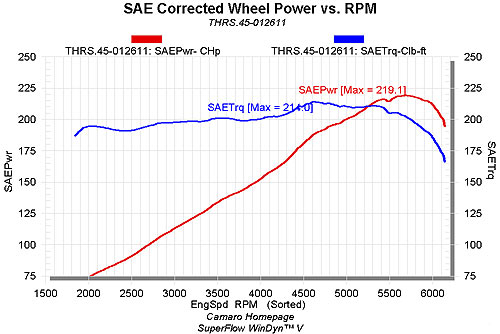 |
|
The latest dyno data has us pretty
happy, actually–were ecstatic! Power is
up. We up 15-hp from last time with most
of that coming at high rpm. Torque has
improved, not only the peak, but the
whole torque curve as flattened
considerably since our last test. The
rpm range of the engine has extended
somewhat, too.
|
|
In Part 5,
we have a few more small intake and exhaust tweaks up
our sleeves. We'll, also tell you a little more about
details of the THRS's engine controls calibration. We'll
do some more suspension work and we'll overhaul the
brakes.
Sources:
|
Daniel Stern Lighting, Inc.
2101-35 High Park Ave.
Toronto, ON, M6P 2R6
866-861-8668
www.danielsternlighting.com |
Rockauto
www,rockauto.com |
Denso Sales
of California, Inc.
3900 Via Oro Av.
Long Beach CA 90810
310.513.8582
www.densoaftermarket.com |
Design Engineering, inc.
604 Moore Rd.
Avon Lake OH 44012-2315
800-264-9472
www.designengineering.com |
Eastwood Company
263 Shoemaker Road
Pottstown PA
19464
www.eastwoodco.com |
EnerSys Energy Products,
Inc. (Odyssey Battery)
617 North Ridgeview Dr.
660.429.2165
www.odysseyfactory.com
|
Extreme Performance Heat
Coatings
515 N. Elevar St.
Oxnard CA 93010
805.485 2667
www.xtremeperformanceheatcoatings.com |
Fikse USA, Inc
6851 S 220th St
Kent, WA 98032
253.872.3888 |
Global West Suspension
Systems
655 S. Lincoln Av.
San Bernardino CA 92408
877.470.2975
www.globalwestsuspensionc.om |
Goodyear Tire and Rubber Co.
see your local Goodyear dealer
www.goodyeartires.com |
Helm,
Inc. (GM Service Manuals)
14310 Hamilton Ave.
Highland Park, MI 48203
800 782 4356
www.helminc.com |
|
Katech,
Inc.
24324 Sorrentino Ct.
Clinton Twp MI 48035
586.791.4120
www.katechengines.com |
Mac Tools
Suite 200
505 North Cleveland Avenue
Westerville OH 43082
800.mac.tool
www.mactools.com |
Quality Auto Service
3460 Falcon St.
Pomona CA 91767
909.596.5502 |
Racetronix
locate dealers at:
www.racetronix.com |
Red Line Synthetic Oil Corporation
6100 Egret Court
Benicia CA 94510
800.624.7958
www.redlineoil.com |
Rockett Brand Racing Fuel
3703 W. Lake Avenue, Suite 75
Glenview IL 60026
800.345.0076
www.rockettbrand.com |
Standard Abrasives Motorsports Division
4201 Guardian St.
Simi Valley CA 93063
800.423.5444
www.sa-motorsports.com |
Tom Henry Racing
Box 68
Bakerstown PA 15007
877.842.4389
www.tomhenryracing.com |
Tucker Tire Service Co.
612 N Azusa
Covina CA 91722
626.331.0663
www.tuckertirecompany.com |
Vericom Computers
Suite 200
14320 James Road
Rogers MN 55374
800.533.5547
www.vericomcomputers.com |
WeatherTech Automotive Accessories
5230 Walnut Ave.
Downers Grove IL 60515
800.441.6287
www.weathertech.com |
Westech Performance Group
Unit C
11098 Venture Av.
Mira Loma CA 91752
951.685.4767
www.westechperformance.com |
Whisper Motorsports
Suite 305
4400 118th Av. North
Clearwater FL 33762
727.573.1292
www.whispermotorsports.com |
Yella Terra USA
1935 Tommy Webb Dr.
Meridian MS 39307
601 485-3355
www.yellaterra.com.au |
Z-Industries
31200 Santiago Rd.
Temecula CA 92592
951.303.6857
www.z-industries.com |
Return
to Project Index Click Here
|